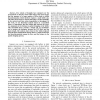Free Online Productivity Tools
i2Speak
i2Symbol
i2OCR
iTex2Img
iWeb2Print
iWeb2Shot
i2Type
iPdf2Split
iPdf2Merge
i2Bopomofo
i2Arabic
i2Style
i2Image
i2PDF
iLatex2Rtf
Sci2ools
GLOBECOM
2007
IEEE
2007
IEEE
Mean-Field Analysis of Buffer Sizing
Two schools of thoughts have emerged over the recent debate on internet router buffer sizing. One school argues that the presence of a large number of flows leads to traffic desynchronization which therefore requires a small buffer size. The other school, however, argues that doing so creates instability in the network and thus causes degradation in throughput. In this work, we use theoretical analysis based on a mean-field theory to demonstrate that the missing link between the above two arguments is the fairness in packet dropping at the buffer. This mean-field theory provides a simple and yet quantitative tool to analyze the dynamics between the TCP flows and the queue length. Our analysis shows that, for the widely deployed drop-tail queue management scheme, there is a trade-off between the desynchronization among the flows and the fairness in the packet dropping process.
| Added | 16 Aug 2010 |
| Updated | 16 Aug 2010 |
| Type | Conference |
| Year | 2007 |
| Where | GLOBECOM |
| Authors | Mei Wang |
Comments (0)

